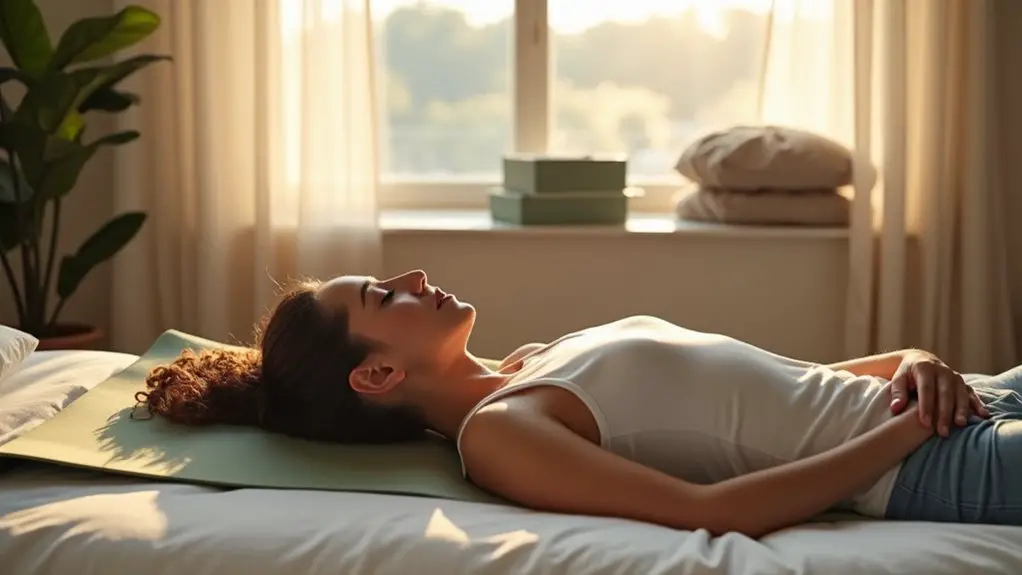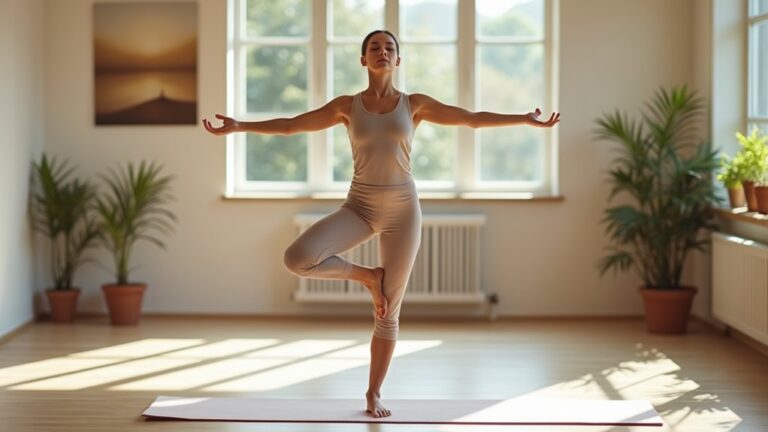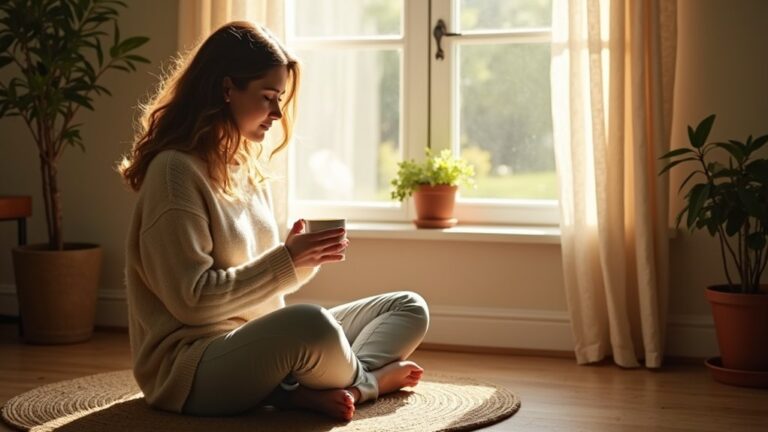The Connection Between Yoga, Meditation, and Better Sleep

When you incorporate yoga and meditation into your routine, you can greatly improve your sleep quality. These practices reduce stress and anxiety by lowering cortisol levels and enhancing melatonin production, preparing your body for restorative sleep. By activating the parasympathetic nervous system, yoga and meditation help you relax, making it easier to fall asleep and stay asleep. As you explore these techniques, you’ll discover how they can transform your sleep patterns and overall well-being, but first, let’s delve into the specifics of how they work.
Reducing Stress and Anxiety
When you’re struggling with anxiety and stress, incorporating yoga and meditation into your routine can be a powerful tool for relief.
Yoga has been shown to be more effective than standard stress management education in reducing symptoms of generalized anxiety disorder, with 54% of yoga participants exhibiting improved symptoms compared to 33% in the stress education group.
Yoga combines physical postures, breathing techniques, relaxation exercises, and meditation, all of which contribute to anxiety reduction.
While yoga may be less effective than cognitive behavioral therapy (CBT) in the long term, it remains beneficial in the short term and is a safe, widely available intervention with no adverse side effects. Regular yoga practice can reduce physiological stress, improve well-being, and enhance sleep quality, making it a valuable complementary treatment option for managing stress and anxiety. Additionally, yoga’s benefits can be sustained for up to three months, although CBT may offer more robust, long-lasting effects.
Regular yoga practice can reduce physiological stress, improve well-being, and enhance sleep quality, making it a valuable complementary treatment option for managing stress and anxiety.
Improving Sleep Quality

Incorporating yoga and meditation into your routine can greatly enhance your sleep quality by regulating your nervous system and promoting deep relaxation.
These practices activate the parasympathetic nervous system, the “rest and digest” system, which lowers cortisol levels and counteracts the “fight or flight” response, calming your body and mind.
Mindfulness in yoga can increase melatonin levels and reduce nighttime sleep disturbances, helping you achieve a sense of calmness and inner peace that translates into your waking life.
Specific yoga poses, such as forward folds and child’s pose, can relax your body, while meditation before bed quiets the mind, making it easier to fall asleep and stay asleep. Meditation also helps by reducing stress and promoting relaxation, which are crucial for improving sleep quality.
Opt for slower, restorative yoga types like Hatha or Nidra before bedtime for the best results. Regular practice can lead to long-term improvements in sleep quality across various age categories.
Increasing Sleep Duration
Incorporating yoga and meditation into your daily routine can greatly impact your sleep quality, benefiting individuals across all age groups.
Yoga practice has been shown to improve sleep quality and duration for children with Autism Spectrum Disorder, pregnant women, and menopausal women, as well as elderly individuals. Regular yoga incorporates mindfulness, breathing awareness, and physical exercise, which contribute to better sleep hygiene and reduce nighttime disturbances. Over 55% of yoga practitioners report improved sleep quality.
Types of yoga like Hatha and Nidra yoga are particularly beneficial when practiced before bed, as they promote relaxation and mimic brain waves during sleep.
While Vinyasa and hot yoga are best practiced earlier in the day to avoid elevating your heart rate. Consistent practice, whether through weekly classes or home routines, is essential for maintaining improved sleep duration over time.
Enhancing REM Sleep and Dream Activity
Enhancing REM Sleep and Dream Activity is essential for overall sleep quality, and yoga and meditation play significant roles in this process.
Yoga reduces stress and anxiety by activating the parasympathetic nervous system, triggering the relaxation response, which creates an ideal environment for entering REM sleep. Incorporating yoga into your bedtime routine signals your body to unwind and prepare for sleep, using gentle, restorative poses like forward bends and supported inversions to relax muscles and relieve physical tension.
This consistent practice conditions your body and mind to enter a state of deep relaxation, facilitating REM sleep. Yoga also integrates the body, mind, and breath, enhancing your body-mind connection and helping you recognize and release bodily tension, leading to deeper relaxation and restorative sleep.
Additionally, techniques like Yoga Nidra, described as yogic sleep, reduce stress and pain, common barriers to REM sleep, and improve sleep quality by activating the parasympathetic nervous system.
Reducing Sleep Latency
When you practice yoga, you can greatly reduce sleep latency, making it easier to fall asleep quickly and improving the overall quality of your sleep. The mechanisms behind this include enhanced mindfulness and awareness, which increase judgment-free awareness, reduce nighttime sleep disturbances, and lower stress levels–all common barriers to falling asleep.
Yoga also increases melatonin levels, aiding in faster sleep onset.
Breathing techniques, such as deep breathing and Ujjayi Breath, are essential in yoga, as they act as relaxation techniques that can induce sleep and reduce stress and anxiety.
Regular yoga practice, particularly structured programs like yoga nidra, has been shown to decrease mean sleep latency markedly, from 3.00 to 1.29 minutes, compared to a smaller reduction in control groups. This is supported by studies showing that yoga nidra practice can improve reaction times for all cognition tasks and enhance sleep efficiency.
Consistent practice sends signals to your body to calm down before bedtime, improving sleep quality and reducing sleep latency over time.
Physiological and Neurochemical Changes
Practicing yoga and meditation can induce significant physiological and neurochemical changes that prepare your body for better sleep. These practices lead to a hypometabolic state, characterized by slower respiration rates, decreased galvanic skin response, and a reduced heart rate. This state is achieved by lowering sympathetic nervous system activation and increasing parasympathetic activation, resulting in a relaxed state.
Meditation also affects your neurochemistry by reducing stress hormones and increasing melatonin and serotonin levels, which facilitate better sleep. Regular practice modulates the activity of the default mode network, reducing rumination and mind wandering, and activates the prefrontal cortex to counteract stress’s negative effects on cognitive functions. Additionally, meditation increases alpha and theta waves, reflecting a state of relaxation and reduced cortical activity, preparing your nervous system for sleep. This process also includes calming stress pathways, which helps slow breathing and lower heart rate and blood pressure, further enhancing the transition into a restful state.
These changes combined help in calming your system, reducing psychological distress, and improving overall sleep quality.
Benefits of Specific Yoga Techniques
Specific yoga techniques can greatly improve your sleep quality by targeting both physical and mental aspects that influence your sleep.
Practices like Legs Up the Wall (Viparita Karani) calm the nervous system and promote blood circulation, which can help reduce swelling in your legs and prepare your body for rest.
Supported Bridge Pose (Setu Bandha Sarvangasana) releases tension in the chest and hip flexors, easing physical discomfort that might keep you awake.
Corpse Pose (Savasana) induces complete physical and mental relaxation, clearing your mind and loosening muscle tension. This pose also incorporates mindfulness techniques, which can increase melatonin levels and reduce nighttime sleep disturbances.
Child’s Pose (Balasana) stretches the back and hips, reducing anxiety, while Knees to Chest (Apanasana) releases tension in the lower back and hips, promoting a deeper, more restful sleep.
These poses can help you fall asleep quicker, sleep longer, and enhance your overall sleep quality.
Implementing a Regular Yoga Practice for Better Sleep
Implementing a regular yoga practice can greatly enhance your sleep quality, especially if you’re susceptible to stress, anxiety, and poor sleep. As a college student, you’re particularly vulnerable to these issues, but yoga can be a powerful tool to mitigate them.
A typical intervention involves a one-time in-person yoga session followed by a recorded yoga video for nightly practice over four weeks. To guarantee compliance, aim to practice yoga for more than 10 minutes each night.
Using standardized screening tools like the GAD-7 for anxiety and PSQI for sleep quality, you can track improvements. You’ll likely see a reduction in sleep latency, increased sleep efficiency, and improved subjective sleep quality.
Additionally, yoga can decrease anxiety symptoms, reduce stress levels, and enhance daytime functioning. Regular practice is also crucial because chronic sleep deprivation can have serious consequences on your health, including impaired cognitive function and increased risk of diseases like diabetes and cardiovascular disease.
Practice yoga at least 30 minutes before bedtime, 2-3 times a week, in a quiet and spacious environment, focusing on breathing, mindfulness, and relaxation techniques to maximize its benefits.
Regular practice is key to experiencing sustained improvements in sleep and mental health.






